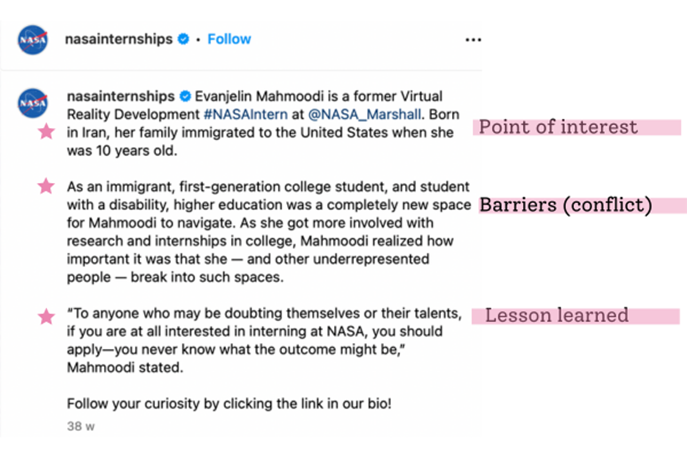Got Employee stories? Try this 3-Part Storytelling Framework
2 min read.
World-renowned screenwriting lecturer, story consultant, and author Robert McKee said, “If our brains are hardware, then story is the software we run to make sense of the world.”
Having great information is one thing, but weaving that information into a story can make your brand sing and come alive. It can mean the difference between talent feeling captivated by your post and idly scrolling past. Research has shown stories are up to 22 times more memorable than plain facts and they can be the most compelling tool in your recruitment marketing strategy if you use them right.
I’m going to share a simple framework, but before that, let’s explore the fundamentals of basic story structure.
Every story includes three states
1. Thesis – everyday reality
2. Antithesis – an event that changes reality
3. Synthesis – a resolution to a new normal
The important thing to note here is the need for change or conflict of some kind. You need conflict to create drama.
Without this, there may be a narrative, but there’s no story. You might think, “Oh, I'm only doing this for employer branding to tell employee stories. We don't want drama.”
But what we really mean by drama is something of interest; something that moves a character forward, something that contradicts or blocks or creates an antagonising crossroads.
Stories can be lengthy and complex, but they can also be incredibly simple. The greatest brand story ever told is, in my opinion, “just do it” because the “it” is personal to the audience. In just three words Nike told a story that powerfully evokes a sense of transformation, inspiring whoever reads it to take action.
The “Care, Conflict, Clarity” framework below is a very simple structure designed to capture the reader’s attention and guide them through a journey in three quick steps. It is particularly useful for describing instances that involve growth or progression in a way that ensures people care it about from the very start.
Care, Conflict, Clarity
Here’s what this structure looks like in practice.
1. I was walking in the park when I noticed a wallet just lying on the ground with what looked like a huge stack of cash in it.
[Our audience cares because that's kind of interesting. It's not just an empty wallet on the ground – there’s something at stake.]
2. Curious, I picked it up and found nearly $2,000 inside. There was identification, but no contact information.
[Now there's an element of conflict, an obstacle to overcome. There's also a moral dilemma. What do we do with the wallet? Some might be tempted to keep the money, especially with the excuse of no contact information.]
3. Instead of keeping it, I decided to locate the owner and return it. The owner explained the wallet contained money for their rent, that they would have been homeless without recovering it and it reminded me that small acts of kindness can make a big difference. It made me feel so good and I found myself looking for more ways to help others all day.
[With the end comes clarity. All loose ends are tied up and the speaker learned a lesson from the experience.]
So, the object of this quick 3-part story structure is to make people care right from the start, identify the conflict or obstacle and then resolve it in a way that causes the speaker, and thereby the reader, to reach a new understanding.
In terms of practical use in employer branding, this format works well with mapping out an employee’s career journey that has obstacles.
Take this Instagram post from NASA’s internship page. Note how it highlights the obstacles Mahmoodi faces and shows clarity through her quote.


A quick note
If you want to capture talent's attention, authentic employee advocacy will always be more trustworthy and captivating than facts and figures. Candidates want to live vicariously through your employees' experience, to see if they can visualise themselves in a similar position.
Try the care, conflict, clarity framework for yourself and see what kind of response it elicits.

